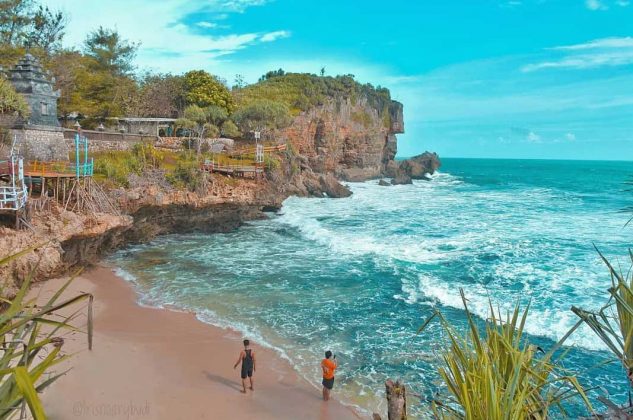Beaches in Gunungkidul Yogyakarta have always their own fascination. Although they are located close each other, but they have their own story and beauty. Ngobaran Beach is well known as Bali of Java, The Uluwatu Temple or Jogja or The Balinese Beach of Jogja. It is because Ngobaran Beach is situated between the cliffs and it has temple on the cliffs.
Ngobaran Beach might not be as famous as other beaches in Jogja but its charm undeniable. Ngobaran Beach is located in Kanigoro Village, Saptosari, Gunungkidul, Yogyakarta. From the city center of Yogyakarta, it will take 1.5 to 2 hours or about 65 km away. There are now many sign board direction of Ngobaran beach so it would make you reach that beach easily.

The origin name of ‘Ngobaran’ is related to ancient history, during Majapahit Empire. The history tells that King Brawijaya V who led Majapahit Kingdom was attacked by his son, Raden Patah, the leader of Demak Kingdom. King Brawijaya V then escaped to the beach because he did not want to fight his own son. Then, Brawijaya V did muksa ritual, self-immolation. The fire from Muksa ritual becomes the origin name of Ngobaran beach. Although this story is still questioned by local people because after the ritual, it was found only dog bones and they didn’t believe that those bones was the bones of King Brawijaya V.
The main attraction of Ngobaran Beach is the strong atmosphere of culture and religion. In 2003, an archway and a statue of a typical Hindu God were built to commemorate King Brawijaya V, which was then inaugurated in 2004. The visitors can also discover the statue of Vishnu who rides Garuda and faces the sea side.
On the left side of that inscription, there is Joglo which is used to Kejawan sect worship. Kejawan sect belief refers to Raja Brawijaya V’s son, Bondan Kejawan. In front of Joglo, you can find Segawa Wukir Temple, an icon of Ngobaran Beach. Segawa Wukir Temple is believed as the place where the ritual of muksa or self-immolation of King Brawijaya V was held. Furthermore there is another worship place, a mosque of 3×4 meters. Uniquely, this mosque faces the sea that’s not like other mosques which face usually to the west side.
However, if the visitors want to pray here, there has been given the correct Qibla direction.
By variety of worship place that’s located on the same area, it indicates the harmony of the religion at that time. In fact, several traditional ceremonies such as the Melasti ceremony before Nyepi and Galungan ceremony were held at Ngobaran Beach. On certain days, there are also worship ritual performed in Kejawan sect.
Besides the harmony of religion and culture, Ngobaran Beach has also beautiful exotic beach views. When the sea water is receding, the visitors can see the seaweed and algae along the beach. The visitors can also see marine life such as lobsters, shellfish and others hiding behind the coral reefs because of this recede of sea water. Those sea animals are usually searched by local people to be sold in the market.

Ngobaran Beach provides also amazing photo spots such as background of cliffs or beach, the temple, and beach with coral reefs. Since the waves are quite strong, it is not suggested to swim at Ngobaran Beach. However, the visitors can enjoy sunset which is truly incredible. The bright orange rays of the sun reflected in the clear sea water.
If you feel hungry, you can try delicious seafood from Ngobaran Beach especially the sea urchin, that usually costs expensive in the restaurant, but in Ngobaran beach you will only pay Rp10,000 to taste fried sea urchin that is so delicious. Don’t forget also to try the seaweed crispy.
The entrance ticket of Ngobaran Beach costs only Rp5,000 per person. In addition the parking ticker costs Rp3,000 for a motorbike and Rp 10,000 for a car. The facilities provided are quite complete where there are spacious parking area, food court and toilets. The exoticism of the beach and strong nuances of culture that make a lot of people are interested in this beach. Have you ever been coming to Ngobaran Beach?




